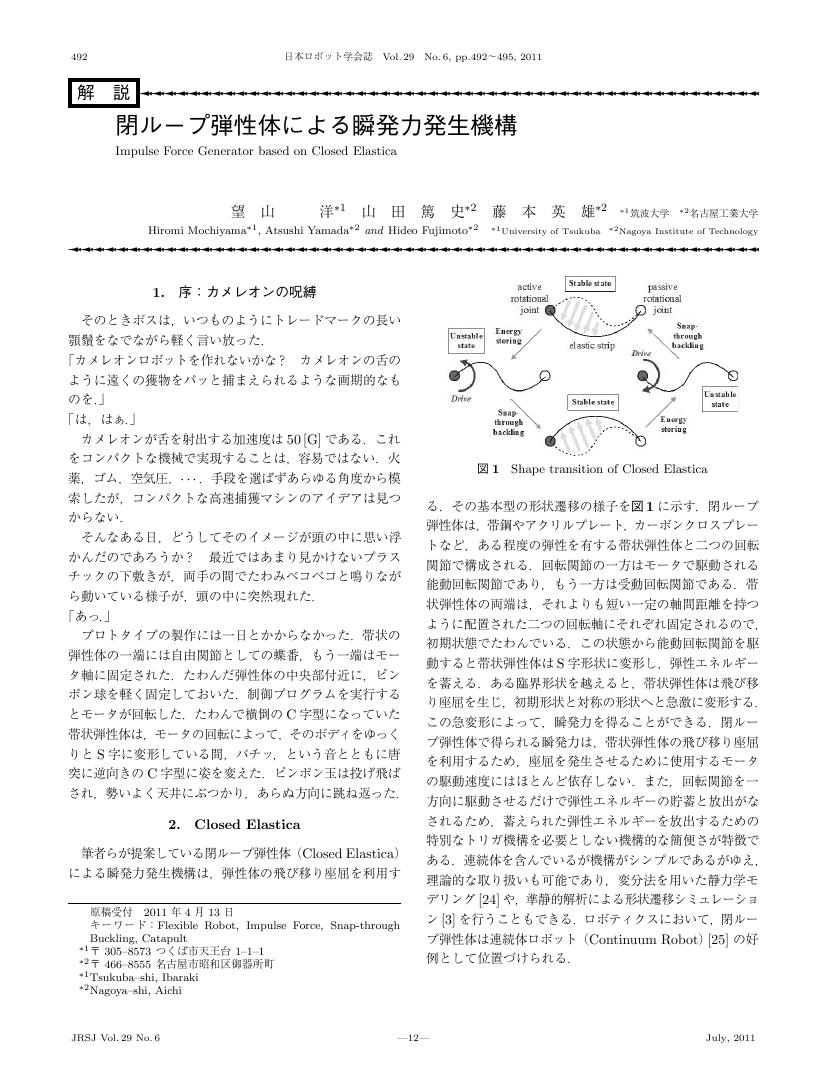21 0 0 0 OA 閉ループ弾性体による瞬発力発生機構
- 著者
- 望山 洋 山田 篤史 藤本 英雄
- 出版者
- 一般社団法人 日本ロボット学会
- 雑誌
- 日本ロボット学会誌 (ISSN:02891824)
- 巻号頁・発行日
- vol.29, no.6, pp.492-495, 2011 (Released:2011-08-15)
- 参考文献数
- 25
- 被引用文献数
- 1 2
3 0 0 0 OA 触覚を増幅する触覚コンタクトレンズ
- 著者
- 佐野 明人 菊植 亮 望山 洋 武居 直行 藤本 英雄
- 出版者
- 横断型基幹科学技術研究団体連合(横幹連合)
- 雑誌
- 横幹連合コンファレンス予稿集 第1回横幹連合コンファレンス
- 巻号頁・発行日
- pp.133, 2005 (Released:2006-06-27)
自動車業界に代表されるものづくりの現場は,デジタル化・自動化が進む中,今なお人の触覚に基づく技(面品質検査など)と感性が重要な役割を担っている.特に,グルーバルな大競争に打ち勝つために,最高の商品性と卓越した製造品質を確保した車両品質の強化が叫ばれている.皮膚や機械受容器細胞の構造には,巧妙な触覚情報処理機構が仕組まれており,その特徴は力学ベースで議論することができる.本研究では,触覚の本質が能動触であることを考慮して,触覚情報処理機構を力学的(動的)側面により解明し,その仕組みや本質的な原理を工学的に応用する.結果的に,必然性の高いデバイス開発が期待できる.本講演では,手掌の皮膚に装着し,触覚刺激を増幅する触覚版のコンタクトレンズについて報告する.触覚コンタクトレンズを用いることで,物体の微小な凹凸を鋭敏に,しかも素早く検出できる.
- 著者
- 高原 駿 望山 洋
- 出版者
- 一般社団法人 日本機械学会
- 雑誌
- ロボティクス・メカトロニクス講演会講演概要集 2013 (ISSN:24243124)
- 巻号頁・発行日
- pp._1P1-F07_1-_1P1-F07_4, 2013-05-22 (Released:2017-06-19)
In this paper, we propose a swimming robot driven by a water jet pump with an active exible nozzle for steering. The proposed robot is of 220[mm] in length and consists of a slim body for entering a narrow space. Experimental results using a prototype of the proposed swimming robot show that the robot not only can swim forward at the average velocity of 0.44[m/s] corresponding about 2[BL/s](body length per second), but also can turn underwater at the average angular velocity of 156[deg/s] with a small turning radius of 160[mm].
- 著者
- 黒木 忍 坪井 広樹 望山 洋 渡邊 淳司
- 出版者
- 特定非営利活動法人 日本バーチャルリアリティ学会
- 雑誌
- 日本バーチャルリアリティ学会論文誌 (ISSN:1344011X)
- 巻号頁・発行日
- vol.19, no.4, pp.589-592, 2014
The tactile roughness perception of fine-texture has been investigated by using non-uniform surface materials such as polishing papers, and it has been difficult to quantitatively discuss the relationship between physical properties of surface texture and perceived roughness. To solve this issue, we developed a novel method of making a surface plate that has close-packed structure with microparticles of single size (uniform surface), and that has pseudo-close-packed structure with microparticles of two sizes (mixed surface). In this paper, we estimated subjective equality of perceived roughness of mixed surfaces in relative to the uniform surfaces, and compared the physical properties of the mixed surface and uniform surface with perceptually equal roughness. We found that perceived roughness can be partially-explained by physical distance between relatively-bigger particles, though it is not the case when the distance is much longer than diameter of the particles.
